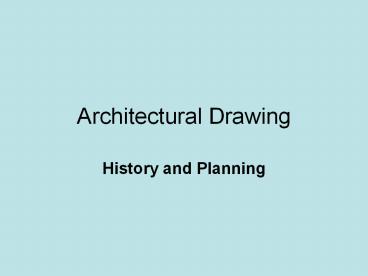Architectural Drawing - PowerPoint PPT Presentation
Title:
Architectural Drawing
Description:
Architectural Drawing History and Planning Architectural history in house construction. Why are historical trends important and how do they influence the way we build? – PowerPoint PPT presentation
Number of Views:372
Avg rating:3.0/5.0
Title: Architectural Drawing
1
Architectural Drawing
- History and Planning
2
Architectural history in house construction.
- Why are historical trends important and how do
they influence the way we build?
3
Wood (1) Stone Brick Glass (hand-made)
England Spain France Germany
Harsh Environment Land Clearing Req. Native
Inhabitants
Hand Tools Human/Animal Power
4
Historical House Styles
English styling
Before 18th Century, Tudor style or Elizabethan.
Stone, brick or stucco- often ½ timbered, steep
roof, diamond windows.
Georgian styling
Early 1700s, Formal symmetrical. Front doors
are pedimented, hip roof
Regency styling
Late 1700s, Like Georgian, but finer details.
Often brick, painted white or yellow with hip
roof. Wall extensions/ copper bay or porch roof
with wrought iron.
5
New England Colonial (salt box) styling
Symmetrical like Georgian- mostly wood, steep
rear roof to shed snow.
Garrison styling
1st break in style- 2nd floor overhangs 1st floor
to aid in fighting off Indian raids.
Cape Cod styling
Small gable roofed house, central chimney, roof
slopes to top of 1st floor- usually symmetrical.
Southern Colonial styling
2-story high porches to shade windows for
cooling.
6
Dutch Colonial styling
Gambrel roof gives a full 2nd story, mostly stone.
French Colonial styling
New Orleans- Plastered faces- pink, yellow,
green. Fancy balcony iron scroll work.
Spanish styling
Appearance of adobe walls, tiled roof, usually
enclosed patio. Ceilings with exposed timbers.
7
Ranch styling
Form Follows Function single story, rambling,
open look
Split Level styling
½ flights of steps through entire house. Split
side-to-side, front-to-back.
Modern styling
Geometric, flat roof, every element should have a
purpose- nothing useless
8
Current Practices
- How are houses constructed today and how have
they changed over the past few decades?
9
Vary among many styles Lots of angles Less
attention to details
Block/Slab Concrete Pre-Cast (trucked to site)
Lumber 1 Composites/Laminates Steel Studding
Water/Waste Run-off Energy Use
Heating sources (gas, oil, wood, coal, electric,
alternates) Electrical Requirements- plan for the
future Thermal Ventilation Considerations
(insulation, venting, landscape)
10
Vocabulary
- Habitation- Housing that someone is living in.
Any structure for living. - Home Economy- Planning a house for flow and use.
- Framing- Building technique. Structural members
of a home - Foundation- Supporting structure for a building.
- HVAC- Heating, Ventilation Air Conditioning
- Solar/Wind Effects- Solar and wind on a home can
effect heating and air conditioning costs. Good
planning can use these effects.
11
Future Planning
- How can we plan and predict future construction
trends?
12
Wood- Less Woodland, Higher Costs Polymers/Composi
tes Concrete/Steel Glass/Ceramics Smart Houses
Global Warming Intense Weather Ice Melting
2000- 6.1 billion people 2050 8.9 billion
people 47 increase
Changing Economies Financial Concerns Population
Centers































